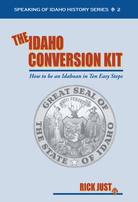In yesterday's post I told the story of the July 1915 kidnapping of Ernest Empey who was a wealthy sheepherder. He had a ranch in Bingham County, east of Wolverine Canyon. That was where the abduction took place.
Empey escaped his kidnapper after almost a week in captivity. The man, who had asked for $6,000 in ransom, was named Leonidas Dean. He had earlier worked for Empey as a sheepherder.
With that abduction fresh in people’s minds, it is no wonder there was speculation about a connection when a second Empey went missing. Seven-year-old Alice Empey, Ernest’s niece, disappeared in April of 1916. She was last seen on her way to attend Sunday school about a mile from her home in Ammon.
Law enforcement authorities questioned Leonidas Dean about the missing girl, though he was not a suspect himself. He was serving one to ten in the Idaho State Penitentiary for the 1915 abduction.
People from communities all around turned out to search for little Alice, but to no avail. A scrap of clothing that included a button was found about a half mile from her house on Friday, April 21. The search took on a new urgency. Friends and neighbors dragged nearby Sand Creek, turning up nothing.
The April 23, 1916 Idaho Statesman reported that searchers had a new theory. Someone remembered a speeding automobile on the road by Alice’s house on the day she disappeared. Maybe they had accidentally struck her and, fearing prosecution, taken her body away and hidden it. The article said, “The search for the child or for her body is being continued far back into the hills by 200 men. If the auto accident theory is disproved there will be nothing to fall back upon save the theory that the child was kidnaped and is being held for ransom from her wealthy relatives.”
But if ransom was the goal, why wasn’t there a note? Two weeks passed and she was still missing. Three weeks passed, then four. Finally, on May 16, 1916, Alice was found. Her body was discovered on a sandbar in Sand Creek. She had not drowned.
Alice Empey, seven years old, had been assaulted and her body mutilated.
Leonidas Dean, in prison for the first Empey abduction a year before, redoubled his denials, writing, “I sympathize with the parents and friends of the murdered girl as much as anyone else and sincerely hope that the assassin may be captured. That he is no friend of mine is certain, but if he were my brother it would make no difference.”
Governor Moses Alexander announced a $1,000 reward from the State of Idaho for the apprehension and conviction of the person or persons responsible for the murder. Several suspects were questioned about the murder, then released. Suspiciously, one of the men questioned committed suicide soon after.
Luke May, a private detective from Salt Lake City, was hired to work on the case. May, sometimes called America’s Sherlock Holmes, had a reputation for using scientific methods for solving crimes. May came to believe that the person who had killed Alice was likely someone who lived off the land and rarely came in contact with people. Just such a man entered the story.
In December, dramatic news came from Hailey. Authorities there had arrested a man for attacking a young girl in her home. He was described by the Capitol News as “a veritable wild man” who had been wandering the mountains around Hailey and around Idaho Falls for the past two years “living on nothing but nuts and the flesh of game.” In the course of their interrogation they learned that Edward Ness had earlier attacked three sisters in the Hailey area, holding them as prisoners in a cabin for a time.
There was talk in Hailey of an imminent lynching, especially when word got out that Ness had confessed to the murder of Alice Empey while under interrogation by Luke May.
That seemed to solve the Alice Empey case, at least until news hit regional papers that Ness had not in fact confessed. Did he confess or did he not? Luke May, the private detective, believed Ness had confessed and had committed the murder, but the man was never charged with it. Instead, he was charged with a crime for which there was solid evidence, a brutal rape, convicted, and sentenced to 20 years in the Idaho State Penitentiary.
And, with that not-quite closure, the story of the entwined abductions of 1915 and 1916 comes to an end, with two men in jail and a family forever shaken. Officially the murder of Alice Empey remains unsolved.
Empey escaped his kidnapper after almost a week in captivity. The man, who had asked for $6,000 in ransom, was named Leonidas Dean. He had earlier worked for Empey as a sheepherder.
With that abduction fresh in people’s minds, it is no wonder there was speculation about a connection when a second Empey went missing. Seven-year-old Alice Empey, Ernest’s niece, disappeared in April of 1916. She was last seen on her way to attend Sunday school about a mile from her home in Ammon.
Law enforcement authorities questioned Leonidas Dean about the missing girl, though he was not a suspect himself. He was serving one to ten in the Idaho State Penitentiary for the 1915 abduction.
People from communities all around turned out to search for little Alice, but to no avail. A scrap of clothing that included a button was found about a half mile from her house on Friday, April 21. The search took on a new urgency. Friends and neighbors dragged nearby Sand Creek, turning up nothing.
The April 23, 1916 Idaho Statesman reported that searchers had a new theory. Someone remembered a speeding automobile on the road by Alice’s house on the day she disappeared. Maybe they had accidentally struck her and, fearing prosecution, taken her body away and hidden it. The article said, “The search for the child or for her body is being continued far back into the hills by 200 men. If the auto accident theory is disproved there will be nothing to fall back upon save the theory that the child was kidnaped and is being held for ransom from her wealthy relatives.”
But if ransom was the goal, why wasn’t there a note? Two weeks passed and she was still missing. Three weeks passed, then four. Finally, on May 16, 1916, Alice was found. Her body was discovered on a sandbar in Sand Creek. She had not drowned.
Alice Empey, seven years old, had been assaulted and her body mutilated.
Leonidas Dean, in prison for the first Empey abduction a year before, redoubled his denials, writing, “I sympathize with the parents and friends of the murdered girl as much as anyone else and sincerely hope that the assassin may be captured. That he is no friend of mine is certain, but if he were my brother it would make no difference.”
Governor Moses Alexander announced a $1,000 reward from the State of Idaho for the apprehension and conviction of the person or persons responsible for the murder. Several suspects were questioned about the murder, then released. Suspiciously, one of the men questioned committed suicide soon after.
Luke May, a private detective from Salt Lake City, was hired to work on the case. May, sometimes called America’s Sherlock Holmes, had a reputation for using scientific methods for solving crimes. May came to believe that the person who had killed Alice was likely someone who lived off the land and rarely came in contact with people. Just such a man entered the story.
In December, dramatic news came from Hailey. Authorities there had arrested a man for attacking a young girl in her home. He was described by the Capitol News as “a veritable wild man” who had been wandering the mountains around Hailey and around Idaho Falls for the past two years “living on nothing but nuts and the flesh of game.” In the course of their interrogation they learned that Edward Ness had earlier attacked three sisters in the Hailey area, holding them as prisoners in a cabin for a time.
There was talk in Hailey of an imminent lynching, especially when word got out that Ness had confessed to the murder of Alice Empey while under interrogation by Luke May.
That seemed to solve the Alice Empey case, at least until news hit regional papers that Ness had not in fact confessed. Did he confess or did he not? Luke May, the private detective, believed Ness had confessed and had committed the murder, but the man was never charged with it. Instead, he was charged with a crime for which there was solid evidence, a brutal rape, convicted, and sentenced to 20 years in the Idaho State Penitentiary.
And, with that not-quite closure, the story of the entwined abductions of 1915 and 1916 comes to an end, with two men in jail and a family forever shaken. Officially the murder of Alice Empey remains unsolved.
Edward Ness was never charged with the murder of Alice Empey, but Detective Luke May was convinced he'd done it.





 RSS Feed
RSS Feed